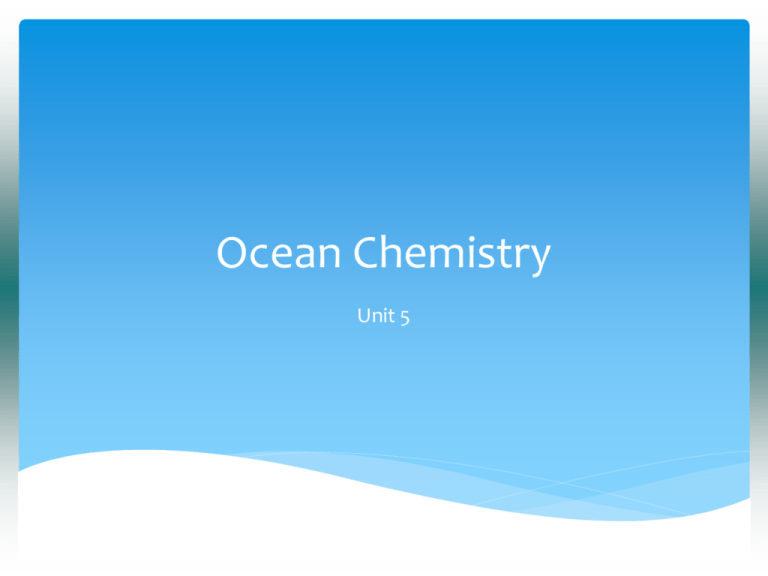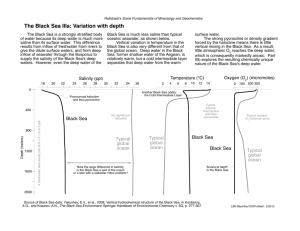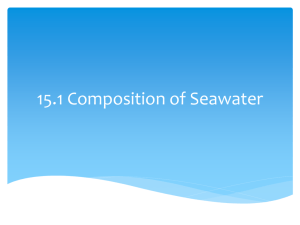Ocean Physics & Chemistry
advertisement

Ocean Chemistry Unit 5 Ocean Chemistry The chemical properties of the ocean are important to understand because the marine environment supports the greatest abundance of life on earth. This life is largely made up of the same chemicals that comprise the ocean—water and salts. Reflection 1. Why is it important to understand the chemistry of the ocean? 2. What is the chemical make-up of the life in the oceans? What is it similar to? Properties of Water H20 is a compound of 2 hydrogen atoms and one oxygen atom in a fixed proportion. Held together by covalent bonds (sharing of e-) Molecular shape is bent into a 105° angle Electrically unbalanced because of the angle and thus considered polar because of the (+) and (-) end H bonds form between water molecules and other charged substances due to the polarity. This allows water to stick to itself, a process known as cohesion Adhesion is when water H bonds to other materials Universal solvent: it will dissolve almost anything Reflection 3. What makes up a water molecule? 4. How is it bonded? Give details. 5. Discuss the polarity of water. 6. Write about its adhesive, cohesive and solvent properties. Seawater NaCl dissolves in water because of it’s polarity 97.2% of Earth’s surface water is marine Seawater is 96.5% water and 3.5% dissolved substances (mostly salts) Earth has 5.5 trillion tons of salt Nearly every element found in the crust and atmosphere is also present in the ocean Major constituents of seawater H, O, Cl, Na, Mg, Ca, K, SO43-, and HCO3- Elements <1 ppm are called trace elements Reflection 7. Use the previous slide to describe marine water (saltwater) in detail. Include in your description all of the properties and composition that is given. Sources of Ocean Salts Weathering running water dissolves crustal rock Excess volatiles hydrothermal vents (underwater volcanoes) on the ocean floor leak chemicals (C02,Cl, S, H, F, N) into the water Chemical Equilibrium The ocean is in chemical equilibrium For the most part, ions are added to the ocean at the same rate they are subtracted Certain ions have longer residency times then others Addition of salts from the mantle and weathering are balanced by the subtraction of minerals bound into sediments Reflection 8. Where do the salts and other minerals in the ocean come from? 9. What is meant by equilibrium? How does the ocean maintain equilibrium? Water and Heat Heat is energy produced by random vibrations of atoms or molecules. Four sources of heat in the ocean: solar energy radioactive decay heat from Earth formation artificial heat from humans Temperature is an object’s response to input or removal of heat. 1°C = 1.8°F O°C is freezing 100°C is boiling About 1m (3.3 ft) evaporates from the surface of the ocean every year. Reflection 10. Define heat. 11. What are four sources of heat in the ocean? 12. Define temperature and note the freezing and boiling points for water. 13. How much water evaporates from the ocean each year? Colligative Properties of Seawater Heat Capacity heat required to raise 1 g of substance 1°C Heat capacity of water is among the highest of all known substances. Water can absorb (or release) large amounts of heat with little change in temp. The heat capacity of seawater decreases with increasing salinity (saltwater is less able to hang on to heat) Colligative Properties of Seawater Salinity total quantity of dissolved inorganic solids in water (NOT just salt!) Salinity is usually 3.3-3.7% depending on evaporation, precipitation, and freshwater runoff Proportion of Cl to salinity is constant: Salinity in % = 1.81 x Cl % As salinity increases, freezing point decreases Gives seawater a natural “antifreeze” property (saltwater freezes at a lower temp than fw) Salt water evaporates more slowly than fw (salt hangs onto water) Colligative Properties of Seawater Osmotic Pressure O.P. of organisms increases with increasing salinity (organisms lose more water when salinity is higher) Reflection 14. What are the 3 given colligative properties of seawater? 15. Describe, in detail, the heat capacity of water. 16. Describe, in detail, the salinity of sea water. 17. How is the osmotic pressure of organisms affected by salinity? Water Density Density of water is a function of salinity and temperature. Seawater density increases with increasing salinity, increasing pressure, and decreasing temperature. Water Density Freezing & Density During the transition from liquid to solid, water expands This makes ice less dense than liquid water, and thus floats. Density of ice is .917 g/cm3 Density of liquid water is .999 g/cm3. Density of water increases as seawater freezes. Ice crystals are pure water because they exclude the salt. The left over cold, salty water is very dense. Water Density Ocean Layers The ocean layers by density stratification. Surface (mixing) zone 2% least dense zone Top of the sea can actually be fw Pycnocline 18% density increases with depth Deep zone 80% below 1000m, densest layer Reflection 18. How does salinity and temperature affect the density of the ocean? 19. Describe in detail, the relationship of freezing temperatures and water. 20. Describe the result of density stratification and the three layers of the ocean associated with it. Pycnocline Thermocline + Halocline = Pycnocline Halocline - the area where the salinity changes rapidly. Thermocline - the layer that changes in temp rapidly. Can range in temp from 30.5-37.5°F Average temp of ocean being 38°F. Water masses (having characteristic temp and salinity, density) get trapped at great depths. The pycnocline isolates 80% of the ocean from the 20% circulating on the surface. Reflection 21. What are the two layers that make up the pycnocline? 22. What is special about each of these two layers? 23. How does the pycnocline isolate 80% of the water in the ocean? Dissolved Gases • • Gases dissolve most readily in cold seawater Plants and animals in the ocean require dissolved gases in order to survive Nitrogen 48% of gas in ocean (atmosphere 78%) living organisms require N to build proteins, but bottom dwelling bacteria must “fix” the N into a useable form for them Oxygen 36% of gas in ocean (atmosphere has 100x more) Primary source of O2 in ocean is from plants most of the oxygen is near the surface and diffuses into the atmosphere Carbon dioxide 15% of gas in ocean (60x more in ocean than atmosphere) used by phytoplankton- low at surface Reflection 24. Where does gas most readily diffuse in the ocean? 25. What are three major gasses found in the ocean? In what quantity is each found? How are they each used in the ocean? pH Acidity (release of H+) and alkalinity (release of OH-) is measured by pH The ocean contains buffers to prevent large swings in pH when acids or bases are introduced pH scale 0-----------------------------7----------------------------14 acid neutral base (alkaline) Reflection 26. Explain how pH works and in specific, the pH of the ocean. The End







